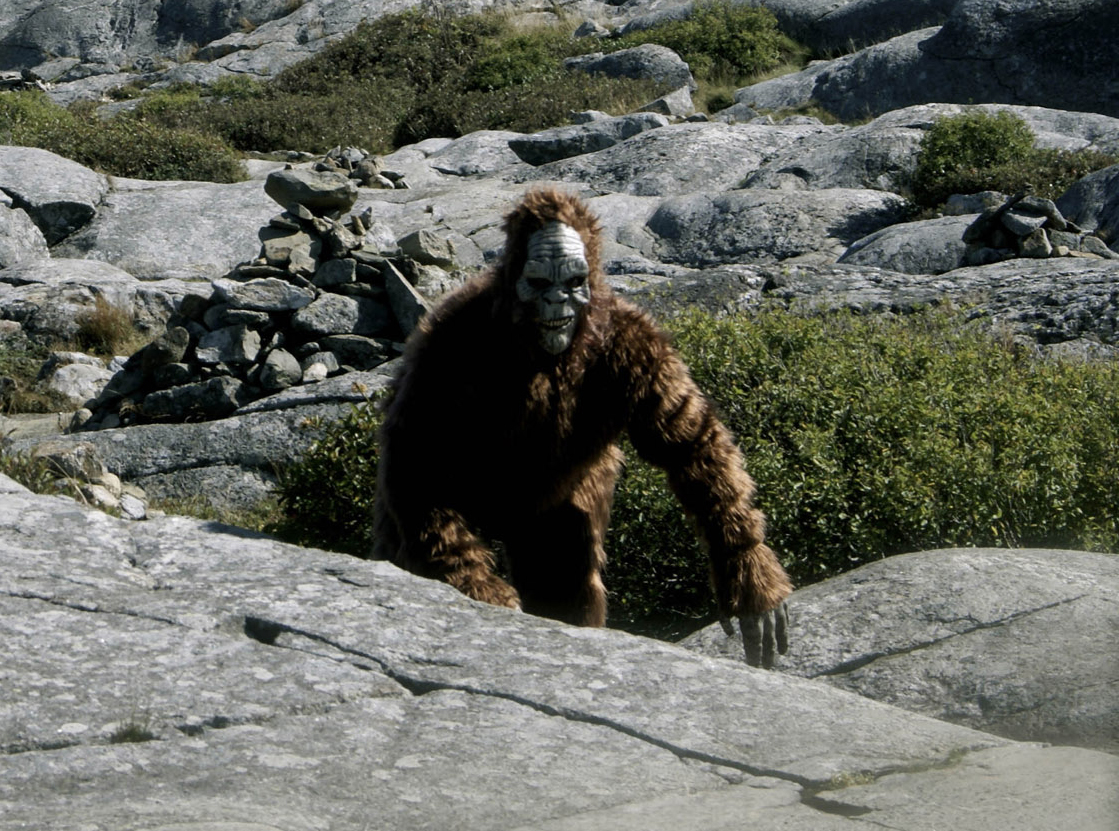VIDEO
This story is featured in today's TimesFreePress newscast.
To some, Bigfoot is just a myth, the product of overactive imaginations and a plaything of hoaxers for decades.
Lori Wade has never been troubled by the doubts of others.
"I just always believed," says Wade, 47, a small-business owner from Ooltewah. "It's like your belief in God; it's just there. That's how I am with Bigfoot. I choose to believe until I'm proven differently."
That belief hasn't always been easy to maintain. When she talks about Bigfoot, people laugh or roll their eyes. Her family takes it in stride but can't match her enthusiasm. Her customers find it charming, if eccentric.
Undaunted, Wade researched on her own. Whenever she was in the woods, she kept a weather eye on the treeline, looking for signs of its presence. She has a Kindle filled with books about the mysterious, reclusive apemen and is a devout fan of Animal Planet's documentary series "Finding Bigfoot."
Recently, she took a more active approach to her search. She applied to the Bigfoot Field Researchers Organization to take part in a four-day expedition to Boone County in northern Kentucky. The BFRO limits participation in its events to those with "serious interest in the subject." Wade was accepted.
Even if she returned without any definitive proof -- no foot casts or fur samples -- Wade was convinced the trip would strengthen, rather than weaken, her belief.
"Fishermen can go all day long without catching a fish, but that doesn't mean they think there aren't fish there," she says. "They'll go to the same lake the next day."
So on April 24, Wade joined 40 others at the expedition site, a 1,000-acre tract of private property abutting a state park. She took along a high-powered audio recorder, a set of night-vision goggles and her convictions.
KEEPING TRACK
Bigfoot has skirted the line between fact and fiction for centuries.
The name, which refers to both individuals and the species as a whole, first was used in a 1958 article in California's Humboldt Times about plaster casts made from enormous footprints found at a local construction site. The name was new, but the alleged owners of the giant feet had been part of American Indian lore long before the arrival of Europeans.
Tribes all over North America have legends of tall, hairy men of the forest. The Cherokee spoke of the white-furred Tsul 'Kalu. The Cheyenne passed down tales of the bird-footed Maxemista. The Salish people of the Pacific Northwest knew of wild men, or Sesquac, whose name is the source of Bigfoot's most common American alias: Sasquatch.
In 1811, David Thompson, a fur trader and surveyor, wrote about discovering a massive, four-toed track in the snow in Alberta, Canada. The track was 8 inches wide and 14 inches long -- about a men's size 20. Thompson believed it to be that of a large bear, but some Bigfoot supporters cite Thompson as the first European to encounter evidence of the creature.
LOCAL LEGEND
Thousands have followed in Thompson's figurative footsteps.
In addition to hosting field expeditions, the BFRO maintains a database of what it describes as credible Bigfoot sightings. Since its foundation in 1995, the organization has posted reports of encounters in every state but Hawaii.
BELIEVE ITAccording to an April survey of 1,250 registered voters by Public Policy Polling, 14 percent of Americans believe in Bigfoot or Sasquatch, and an additional 14 percent were "not sure." By comparison, 29 percent of respondents said they believe aliens exist.
About 4,300 incidents are listed, including about two dozen in the Chattanooga area, some dated from 1974. The most recent was from September 2011, when two motorists say they saw a tall creature crossing a road near Sale Creek on a rainy night.
Local independent Bigfoot researcher JP Pruett, 66, says she had a similar sighting last fall while driving home on a rural road from an amateur photo shoot in Blue Ridge, Ga. She says she noticed an extremely tall, man-like shape that appeared to be holding something while keeping pace with the car, which was traveling about 35 mph. After half a mile, it turned off the road and disappeared into the woods.
Pruett says she first became interested in Bigfoot long before seeing it firsthand. More than 40 years ago, while living in eastern Oklahoma, she began hearing tales of encounters between humans and peaceful creatures she refers to as "the forest people."
Despite some depictions of Bigfoot as primitive, Pruett says those stories, and her own experiences, have led her to believe that the creatures are not only real but more intelligent than many assume.
"People need to open their eyes and see that we're not alone here," she says. "These Sasquatches ... are almost as human as we are."
In June 2005, Roane County resident Matt Seeger's son told his father he was working outside late at night when he saw a large, fur-covered creature watching him from about 30 feet away. He approached it, but Seeger's son says it turned to run into the forest, crossing a 45-foot stretch of road in four enormous strides.
Seeger tried to report the incident to Bigfoot organizations, and when they ignored him, he founded his own database. That site, EastTennesseeBigFoot.org, has compiled 20 reports of encounters in East Tennessee, which he describes as an ideal Bigfoot habitat.
Loren Coleman is a Bigfoot researcher, author and founder of the International Cryptozoology Museum in Portland, Maine. He agrees with Seeger's assessment of the Southeast's appeal as a habitat, though he says local reports may not be of Bigfoot but a more southerly species known alternatively as Skunk Ape, Swamp Ape, Booger or Nape.
In response to emailed questions, Coleman writes that the Skunk Ape is smaller and "more common" than Bigfoot. Based on reports, Skunk Ape's range overlaps with Bigfoot's, but both easily could coexist here, he says.
"The region contains enough biomass for both to survive," Coleman says. "There is a long history of both kinds in the South."
SCIENTISTS AND SKEPTICS
WHAT'S IN A NAMEAmerica has Bigfoot or Sasquatch, but the existence of a race of hairy, manlike creatures living in the wilderness is a belief shared by cultures around the world.Tibet/Nepal: YetiChina: YerenRussia: AlmasAustralia: YowieIndonesia: Orang-pendekSouthern U.S.: Swamp Ape/Skunk ApeGuyana: Mono GrandeAlaska/Arctic circle: ToonijukCanada/Indian American: WendigoBrazil: MapinguariGuatemala: SisemiteJapan: HibagonIndia: Mande BurungAfghanistan/Pakistan: BarmanouSpain: BasajuanSouth Africa: WaterbobbejaanPapua New Guinea: KayadiNew Zealand: MoehauTOP SPOTSAccording to the Bigfoot Field Researchers Organization database, these are the states with the most reported encounters with Bigfoot-like creatures:WashingtonCaliforniaFloridaOhioOregonIllinoisTexasMichiganColoradoGeorgiaSources: Bigfoot Field Researchers Organization, various Internet sites
Bigfoot long has been considered a myth, but many supporters point to research published in a scientific journal last February as conclusive proof of its existence.
The five-year study, which was published in the inaugural issue of the DeNovo Journal of Science, was based on DNA analysis of 111 hair, blood and tissue samples. The study suggests Bigfoot emerged about 13,000 years ago as a hybrid of human beings and an unknown species of ape.
However, critics have expressed suspicion of the study's validity. The lead researcher, Texas-based veterinarian Melba Ketchum, wrote on her website, SasquatchGenomeProject.org, that the study initially passed peer review at another journal, whose legal counsel advised against releasing it due to the risk of damaging the publication's reputation. In response, Ketchum says, her team acquired the rights to the journal and renamed it DeNovo shortly before the first issue was published. This has led some critics to allege Ketchum was seeking publication without true peer review.
The DNA study drew international attention, in part because scientists historically have considered the concept of a 7- to 9-foot-tall mammal -- according to most reports -- escaping widespread detection as unlikely, bordering on impossible.
Last November, organizers of a Bigfoot convention petitioned the New York Department of Environmental Conservation to enact a statewide nonhunting regulation for Sasquatch. In response, the state's chief wildlife biologist, Gordon Batcheller, denied its existence outright.
"The simple truth of the matter is that there is no such animal anywhere in the world," he writes. "I am sorry to disappoint you. However, no program or action in relation to mythical animals is warranted."
UNDAUNTED
Whether real or mythical, Bigfoot's existence is as aggressively debated as the question of a faked moon landing or the alleged crash of an alien spacecraft in Roswell, N.M.
A post to the newspaper's Facebook profile requesting reports of local encounters with Bigfoot received a flood of responses. Within a day, it had been viewed more than 30,000 times, shared more than 180 times and had received about 90 comments.
Some respondents were open to the idea of Bigfoot's existence.
"So a man can walk on water, then change it to wine, rise from the dead and heal people with a single touch. But Bigfoot can't be real?" writes Chad Rigler. "God works in mysterious ways."
Others were fiercely opposed.
"Get real!!" writes Tina Marie Scully. "Bigfoot in our area? Now that makes me laugh. What a joke."
As it turned out, Bigfoot didn't show up in Northern Kentucky, either.
Wade returned from her expedition empty-handed, although she and her teammates did hear an unexplained noise they think might have been a Bigfoot call.
Nevertheless, she says, the experience of being around dozens of people who shared her interest and belief was refreshing. She's already planning to join another expedition, perhaps to the Pacific Northwest.
As to the naysayers who think she's wasting her time -- nothing has changed, she says.
"I do believe, and I'm not embarrassed by it," she says. "Everyone has the right to their own thoughts. I'm not crazy. I just have my own beliefs. To each his own."
Contact staff writer Casey Phillips at cphillips@timesfreepress.com or 423-757-6205. Follow him on Twitter at @PhillipsCTFP.

